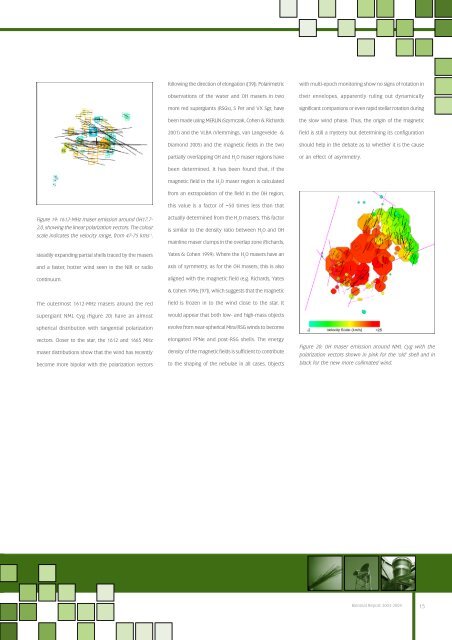Biennial Report 2003-2004 - Merlin
Biennial Report 2003-2004 - Merlin
Biennial Report 2003-2004 - Merlin
You also want an ePaper? Increase the reach of your titles
YUMPU automatically turns print PDFs into web optimized ePapers that Google loves.
Figure 19: 1612-MHz maser emission around OH17.7-<br />
2.0, showing the linear polarization vectors. The colour<br />
scale indicates the velocity range, from 47-75 kms-1 .<br />
steadily expanding partial shells traced by the masers<br />
and a faster, hotter wind seen in the NIR or radio<br />
continuum.<br />
The outermost 1612-MHz masers around the red<br />
supergiant NML Cyg (Figure 20) have an almost<br />
spherical distribution with tangential polarization<br />
vectors. Closer to the star, the 1612 and 1665 MHz<br />
maser distributions show that the wind has recently<br />
become more bipolar with the polarization vectors<br />
following the direction of elongation ([39]). Polarimetric<br />
observations of the water and OH masers in two<br />
more red supergiants (RSGs), S Per and VX Sgr, have<br />
been made using MERLIN (Szymczak, Cohen & Richards<br />
2001) and the VLBA (Vlemmings, van Langevelde &<br />
Diamond 2005) and the magnetic fields in the two<br />
partially overlapping OH and H 2 O maser regions have<br />
been determined. It has been found that, if the<br />
magnetic field in the H 2 O maser region is calculated<br />
from an extrapolation of the field in the OH region,<br />
this value is a factor of ~50 times less than that<br />
actually determined from the H 2 O masers. This factor<br />
is similar to the density ratio between H 2 O and OH<br />
mainline maser clumps in the overlap zone (Richards,<br />
Yates & Cohen 1999). Where the H 2 O masers have an<br />
axis of symmetry, as for the OH masers, this is also<br />
aligned with the magnetic field (e.g. Richards, Yates<br />
& Cohen 1996; [97]), which suggests that the magnetic<br />
field is frozen in to the wind close to the star. It<br />
would appear that both low- and high-mass objects<br />
evolve from near-spherical Mira/RSG winds to become<br />
elongated PPNe and post-RSG shells. The energy<br />
density of the magnetic fields is sufficient to contribute<br />
to the shaping of the nebulae in all cases. Objects<br />
with multi-epoch monitoring show no signs of rotation in<br />
their envelopes, apparently ruling out dynamically<br />
significant companions or even rapid stellar rotation during<br />
the slow wind phase. Thus, the origin of the magnetic<br />
field is still a mystery but determining its configuration<br />
should help in the debate as to whether it is the cause<br />
or an effect of asymmetry.<br />
Figure 20: OH maser emission around NML Cyg with the<br />
polarization vectors shown in pink for the ‘old’ shell and in<br />
black for the new more collimated wind.<br />
<strong>Biennial</strong> <strong>Report</strong> <strong>2003</strong>-<strong>2004</strong> 15


